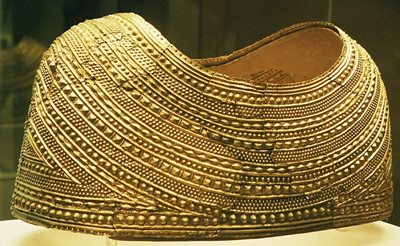The collection of small amber beads, for example, that were found with the cape, must have come from the Baltic-hundreds of miles away from Mold.
与披肩一起出土的號拍珠便来自距莫尔德千里之遥的波罗的海。
By studying these precious objects-gold, amber, and above all bronze-we can track a web of trade and exchange that reaches from North Wales to Scandinavia, and even to the Mediterranean.
通过研究这些贵重的黄金、琥珀与青铜,我们能追寻到一个从北威尔士到斯堪的纳维亚,甚至远至地中海的贸易与交换网络。我们甚至能定位各种物品的原产地。
The Mold Cape was buried only a matter of miles away from the largest Bronze Age copper mine in northwest Europe, the Great Orme.
莫尔德披肩的出土地离青铜时代欧洲西北部最大的铜矿大奥姆山较近。
The copper from here, and the tin from Cornwall, would have provided the ingredients for the vast majority of British bronze objects.
来自此地的铜与来自康沃尔的锡为当时英国绝大部分的青铜制品提供了主要原料。
The peak of activity at the Great Orme mine has been dated between 1900 and 1600 BC.
大奥姆铜矿开釆的巅峰期应为公元 前一千九百年至公元前一千六百年。
Recent analysis of the gold-working techniques, and the decorative style of the cape, dates the burial to this very period.
通过对黄金加工技术及披肩装饰风格的分析,我们确定这一墓葬也属于同一时期。
So we can only guess, but it's likely that the wearers of this extraordinary object were linked to the mine, which would have been a source of great wealth, and a major trading centre for the whole of north-west Europe.
因此,尽管我们只能猜测,但这件披肩的主人很可能与大奥姆铜矿有某种关联,因为铜矿会带来巨大的财富,同时,那里也是整个欧洲西北部的一个大型贸易中心。
But was the gold for the cape also traded from far away? Here's Dr Mary Cahill, from the National Museum of Ireland:
但用来制作披肩的黄金,是否也是从别的地方交易而来的昵?爱尔兰国家博物馆的玛丽卡希尔博士说:
"It has been a huge question-where did the gold come from?
黄金从何而来?这是个重大问题。
We have learned a great deal about where the early copper sources are, but the nature of gold-especially if it's coming from rivers and streams, and because the early workings can literally be washed away in one flood, for example-it means that it's very, very hard to identify the sites.
我们对早期的铜矿来源巳有 不少了解,但黄金的产地却很难追寻,尤其是黄金多为出自河流的沙金,早期的开采痕迹极易被洪水冲洗干净。



